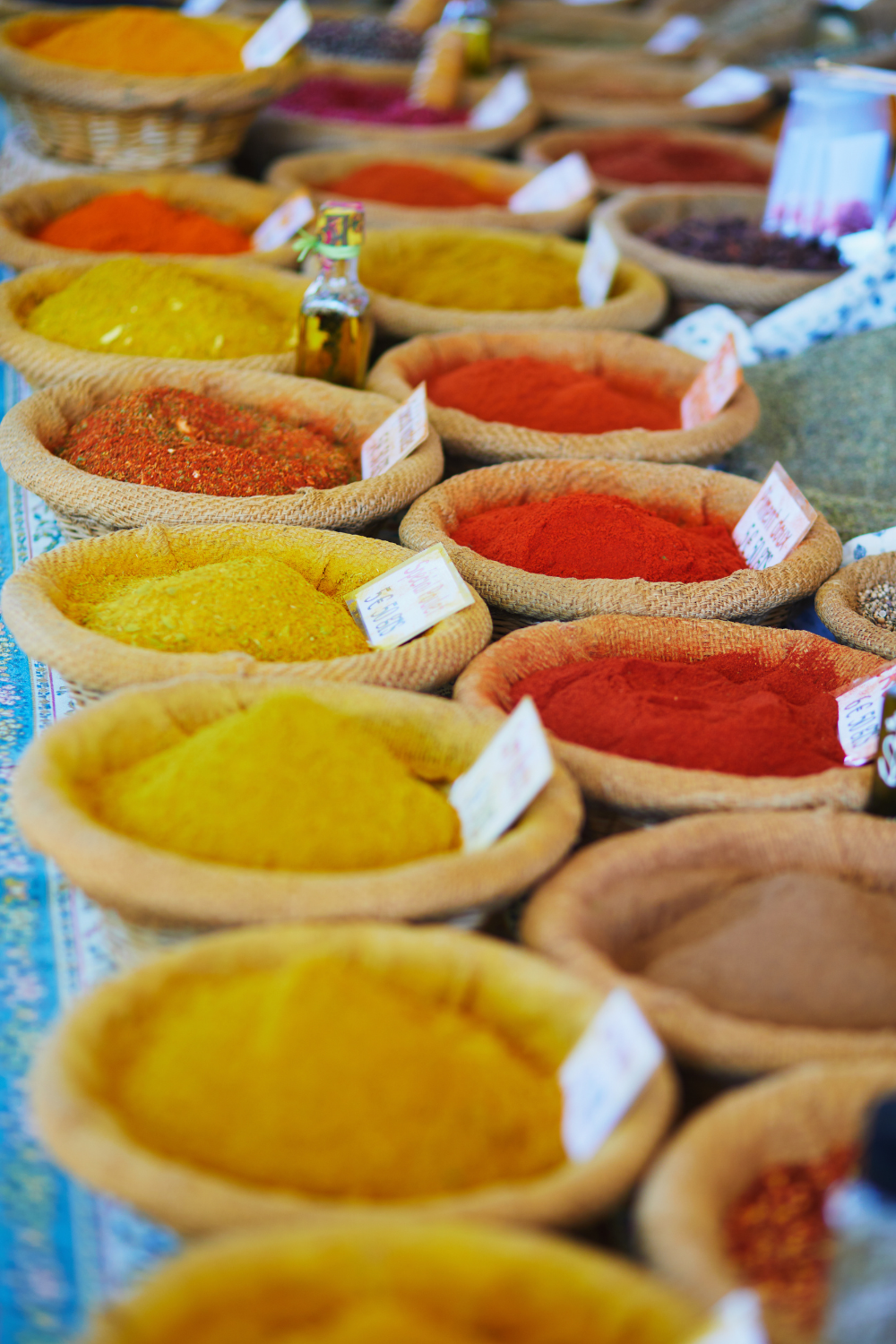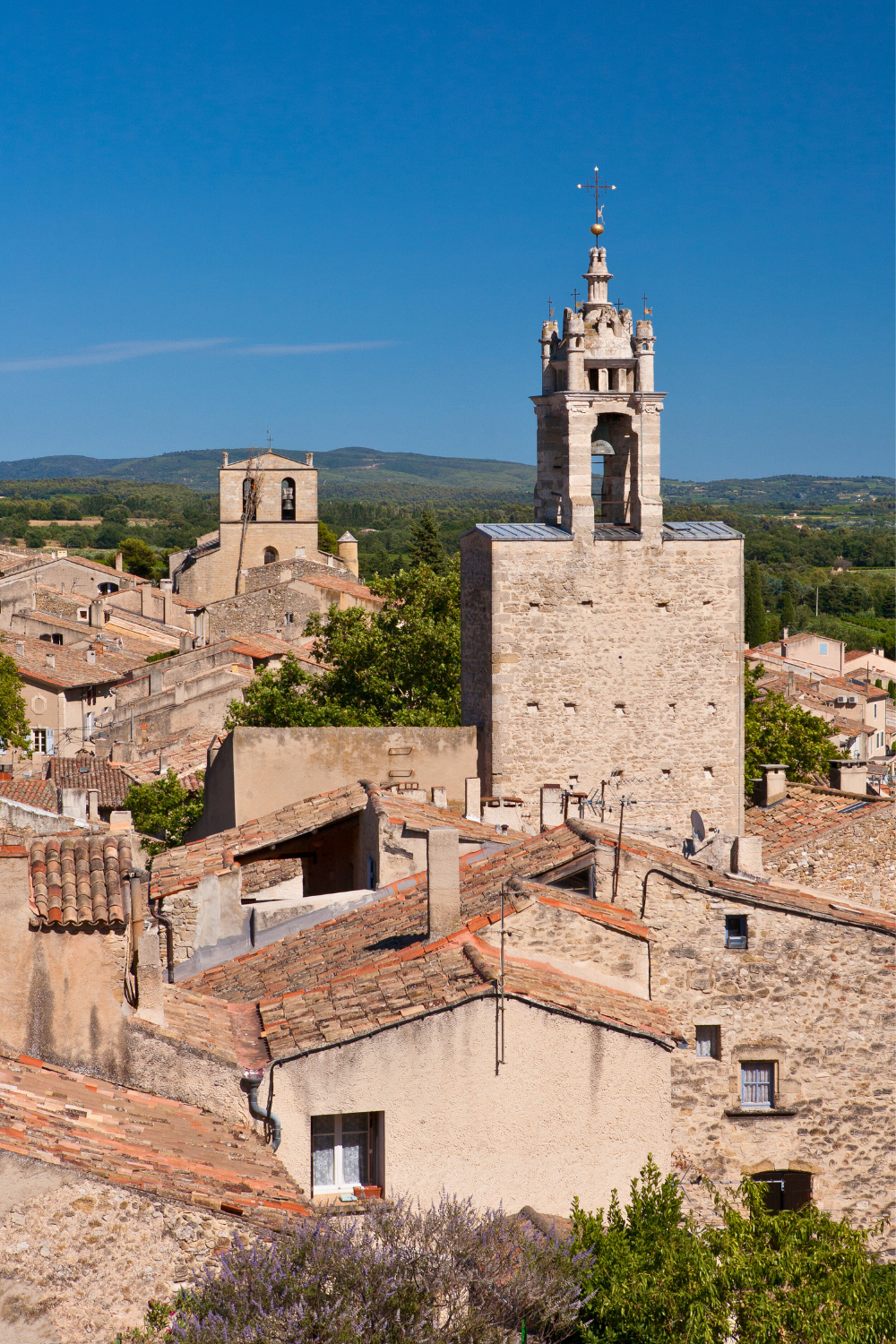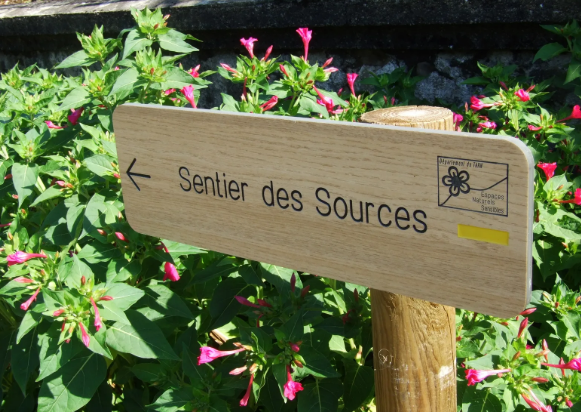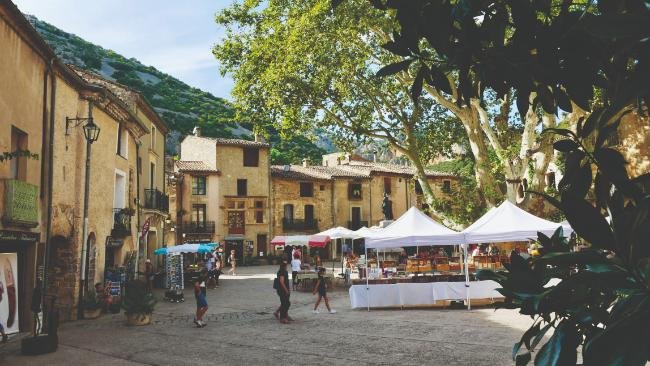6 Authentic French Market Towns for a Peaceful Weekend
Not every market in France smells like lavender and feels like a film scene. Some are packed, commercial, and curated for camera clicks. But then there are the others — the quiet ones. The ones that still feel local. Still feel lived-in. Still feel like France.
This list is for the travelers who get up early just to see a square wake up. Who carry baskets instead of phone tripods. Who want fresh goat cheese, sun-warmed fruit, and a few kind words from the person who grew it.
These are six of the most peaceful, authentic, and under-the-radar market towns in France — the ones that aren’t all over TikTok (yet), but will remember long after summer ends.
1. Saint-Antonin-Noble-Val – Tarn-et-Garonne
📍 Occitanie | Sunday Market
This riverside village isn’t just beautiful — it’s timeless. Nestled at the foot of the Roc d’Anglars cliffs and tracing the curve of the Aveyron River, Saint-Antonin-Noble-Val is one of those places where you can almost hear the centuries in the stone. Its Sunday market is one of the oldest in the region, but it’s never lost its sense of local rhythm.
From around 8:30 a.m., the town begins to wake — shutters open, bread smells drift through the alleyways, and the square fills gently with life. Stalls spill through the medieval streets, wrapping around the town hall and under ancient arcades. You’ll find seasonal fruit (especially plums and wild strawberries in early summer), herbal teas, handmade pottery, and wheels of cheese that taste better than their labels can explain.
But it’s not just the goods — it’s the vibe. Locals stop to chat between stalls, the cheese vendor jokes with the woman who runs the brocante, and there’s a quiet confidence to how everything moves.
Saint-Antonin draws visitors, yes — but not the kind who come to tick boxes. There are no cruise tours, no loudspeakers, and no pressure to rush. Most of the people at the market either live nearby or return year after year because this place feels like a well-kept secret they’re a part of.
What makes it extra special (that no one else tells you):
The market is just the beginning of what this town offers. After your stroll, walk down to the old lavoir — the covered washhouse by the river — and sit quietly as the water moves past. Or take the back lane behind the church, where you’ll find micro-gardens, tiny plaques with hand-written poetry, and views that photographers never seem to share.
If you stay overnight (which you should), catch golden hour from the Roc d’Anglars viewpoint. The short hike up is worth it — you’ll see the rooftops below, the market stalls long gone, and the sky turn pink over the river valley.
Rent a kayak from “Les Pieds dans l’Eau” just outside town after your market morning. The river route from Saint-Antonin toward Cazals is shaded, peaceful, and drifts beneath limestone overhangs. It’s not a tour — it’s your own pace, your own summer story.
2. Cucuron – Luberon, Provence
📍 Vaucluse | Tuesday Market
Set at the edge of the Luberon Natural Park, Cucuron is the kind of Provençal village that feels like it slipped past the guidebooks unnoticed. You won’t find tour buses here. Instead, you’ll find linen-clad locals collecting their groceries by bicycle, neighbors chatting under ancient plane trees, and the soft clink of glasses from a terrace you’ll want to stay on all afternoon.
The Tuesday morning market in Cucuron isn’t large — but it’s layered with charm. It takes place around the town’s signature feature: a giant 14th-century stone basin, known as the étang, shaded by rows of towering trees. Ducks glide across the surface, café chairs lean slightly into the gravel, and the market gently unfurls around them — almost like it grew there naturally.
What you'll find here:
Fresh apricots, white asparagus, and wild strawberries in early summer. Heirloom tomatoes in every shade of red. Olive oils and tapenade pressed just a few kilometers away. Soap blocks still dusted in lavender pollen. And local fougasse bread warm enough to eat while you wander.
What makes Cucuron different from other Provençal markets isn’t its variety — it’s the atmosphere. Nothing feels curated. There are no scripted “market tours.” Just local rhythm, gentle interactions, and real produce for real people.
Even during the peak summer months, the pace remains soft. Locals bring their own woven bags and know exactly who to visit. You’ll see the same people every week, nodding to each other as they pass. The market doesn’t perform — it just continues, the way it always has.
If you walk to the back of the square, beyond the more visible stalls, there’s often a small table with a handwritten sign selling foraged herbs and dried flowers from the hills above the village. The woman who runs it sometimes adds seasonal tisanes or herbal oils she’s made herself. It’s quiet, unadvertised, and very special.
Where to rest after a busy market day:
Order a café noisette from Café de l'Étang, grab a bench in the shade, and just sit. Watch the ducks. Watch the apricot boxes disappear one by one. This is the kind of Provençal morning that doesn’t need to be filled — it needs to be felt.
The Étang de la Bonde, just a short drive or bike ride from the village, is a tranquil, locals-only lake with clear, swimmable water. Bring your market picnic, a towel, and a good book — and let the afternoon stretch on with no plan at all. A great sunset spot!
3. Dieulefit – Drôme Provençale
📍 Auvergne-Rhône-Alpes | Friday Market
Dieulefit is a town that doesn’t raise its voice. It doesn’t try to be photogenic, trendy, or on your radar — and somehow, that’s exactly why it stays with you. Tucked between sun-drenched hills and lavender-covered slopes in the Drôme Provençale, this is a place where people still stop to greet each other in the street and no one checks their watch.
The Friday market is its heartbeat. From early morning, the center of town gently fills — not with tour groups, but with locals and nearby villagers arriving for their weekly essentials. You’ll hear the low hum of conversation, the occasional bark of a market dog, and the scent of fougasse drifting through the square.
What you’ll find:
Artisan ceramics, many shaped just a few doors down
Goat cheese wrapped in chestnut leaves and sold by the same woman who made it
Lavender sachets, jars of quince jam, hand-cut soap blocks
Local vegetables that still have soil clinging to their roots — proof they were picked just hours before
There’s no showmanship here. Just people who care about what they make and grow.
No music blaring, och color-coded food tours. Just a steady stream of human connection, and a pace that lets you notice things. Like the way sunlight filters through the plane trees, or how a vendor hands you change with both hands, making eye contact and smiling as they do.
In the afternoon, we recommend you to grab a linen bag, fill it with picnic staples — goat cheese, crusty bread, a peach or two — and walk the Sentier des Sources (Trail of the Springs). It’s not just a walking path. It’s a winding trail that smells like rosemary and old pine, where you’ll pass wildflowers, clear water springs, and — more often than not — no one at all.
A few streets beyond the main square, you’ll often find a small setup in front of a pottery workshop — unscheduled, unmarked, just a few pieces of stoneware and a handwritten sign that says “fait à la main.” If the door is open, you’re welcome to peek in. Ask (gently, in French if you can) and they’ll likely tell you about the clay, the glaze, and the story behind the piece.
The town is also known for its healing air — officially recognized as therapeutic. It once housed open-air sanatoriums, and the locals will quietly tell you it’s still a place people come to breathe differently. Not dramatically. Just… softer.
4. Sainte-Foy-la-Grande – Dordogne
📍 Nouvelle-Aquitaine | Saturday Market
Tucked beside the Garonne River, this lesser-known bastide town might not make the front page of glossy travel magazines — but that’s exactly why it’s magic. Sainte-Foy-la-Grande’s Saturday market is one of those rare finds: large enough to spend a good hour wandering through, yet small enough to feel like you’ve been let in on a secret.
Set in the town’s 13th-century square under arcaded walkways, the market stretches out like a living postcard. Locals arrive with wheeled baskets, kids run ahead for crepes, and vendors lean on counters chatting between customers. There’s a rhythm here — a warm, welcoming, completely unforced kind of energy.
What you’ll find:
Heirloom tomatoes in dusty crates, some still warm from the sun
Wild chanterelle mushrooms and herbs foraged by hand
Buttery croissants and pain au chocolat from the boulangerie on Rue Victor Hugo
Local honey, walnut oil, duck confit, and canelés that melt in your mouth
You’ll also find small-batch wines, handmade baskets, and occasionally, someone playing the accordion softly near the corner café — not as a performance, but simply as part of the morning.
This market isn’t trying to go viral. It exists because it’s useful. Because locals depend on it. There are no staged photo setups or curated “Provence in a bag” displays. Just a genuinely functional market that happens to be beautiful.
Insider tip: Ask for the “noix du Périgord” (local walnuts), and you’ll often be handed a small paper bag with cracked shells. The walnut oil here is also exceptional — darker, more aromatic, and pressed just outside town.
We redommend you to start the day with a coffee or hot chocolate under the arcades of the Place du Marché. Watch as regulars greet their favorite vendors with cheek kisses and folded napkins. Then, walk down Rue Chanzy toward the Garonne River — just five minutes away. You’ll find a shaded path along the banks, quiet picnic spots, and ducks napping in the reeds.
If you're staying nearby, come back late Friday night — some vendors start setting up under the soft orange glow of the streetlamps, and it gives the square a dreamlike stillness that’s rare in summer France.
5. Castelnau-de-Montmiral – Tarn
📍 Occitanie | Tuesday Market (summer only)
High above the Tarn Valley, where vineyard rows spill over golden hills and time seems to curl around the stone, you’ll find Castelnau-de-Montmiral — a medieval village so serene, it feels like a place that forgot to rush forward. Despite being one of France’s official “Plus Beaux Villages”, it remains blissfully low-key. No crowds. No line for parking. Just sleepy charm and honey-colored stone.
During the summer months, the village hosts a tiny Tuesday market under the shade of ancient arcades in the central square. It’s not flashy. It’s not busy. But it’s one of those moments that travel rarely gives you: genuine stillness.
What you’ll find:
Small wooden crates filled with sun-ripened plums and early peaches
Lavender sachets sewn by hand and tied with rustic string
Hand-poured beeswax candles and locally made silver jewelry
Fresh herbs cut from gardens just beyond the village walls
Only a few stalls set up — maybe six or seven — but each one is worth pausing at. The vendors don’t rush their customers. They’ll tell you how they infused the oil, where the rosemary grows best, or why this summer’s apricots are sweeter than last year’s.
Castelnau is simply too tucked away for the mainstream crowd. The drive up the hill deters the rush. Most visitors who do arrive are from nearby towns — here to pick up a few things, have a chat, and linger over coffee.
What makes it extra special:
The town square is silent the rest of the week, so the appearance of the market — even in its smallness — feels like an opening of doors. Locals bring out benches, cafés open earlier, and everything unfolds with this lovely, gentle hum.
After the market, drive toward Gaillac, stopping in at one or two of the region’s family-run wineries (many are open for walk-in tastings). The Route des Vins du Gaillac is peaceful, green, and winding — with no hurry and no pressure to buy.
6. Saint-Guilhem-le-Désert – Hérault
📍 Occitanie | Thursday Market (small, seasonal)
Tucked deep within the limestone folds of the Hérault Gorges, Saint-Guilhem-le-Désert is the kind of place that stirs something in you — even before you step out of the car. The cliffs rise suddenly, the air turns cooler, and you feel it: the quiet. Officially designated as one of France’s Plus Beaux Villages and part of a UNESCO World Heritage site, it still carries the kind of silence that can’t be faked or filtered.
Its Thursday market is tiny, seasonal, and beautifully understated. Just a few stalls tucked beneath stone arches and climbing vines — but each one feels like it belongs here. The setting is part monastery, part time capsule, and entirely unforgettable.
What you’ll find:
Seasonal fruit from the nearby plains: cherries, apricots, or wild figs depending on the month
Artisanal bread baked in wood-fired ovens, with rough crusts and soft interiors
Soaps, herbs, and honey made just beyond the gorge
The occasional stall with handwoven baskets or embroidered linen sachets
It’s not a shopping destination. It’s a moment — and if you don’t rush it, it lingers.
Most visitors only stop in briefly — a quick photo, a peek at the abbey — then move on. But those who stay (especially midweek) discover something else entirely. In the early morning, you might hear only the river and the low creak of shutters opening. By mid-afternoon, the square settles into a sunlit hush. You’ll sit beneath vines with a glass of rosé and think, “Why did no one tell me about this?”
What we’d do in the afternoon:
Behind the market stalls, past the abbey and the last café, there’s a narrow passage leading to a small footpath along the cliffs. It’s not marked on every map — and that’s the best part! Follow it slowly. Bring fruit and a notebook. There’s a stone bench about 15 minutes in, completely hidden from the village, where you’ll hear nothing but birds and the river far below.
If you have time, we recommend walking the trail from the Abbaye de Gellone to the Pont du Diable (Devil’s Bridge) in the golden hour. It’s short (about 30 minutes), easy, and gives you an unforgettable view of the village folding into the landscape as the sun hits the cliffs.
If you can stay overnight (just a handful of rooms available), do it. The village empties in the evening, leaving you with lantern-lit lanes, the sound of water in stone basins, and a kind of stillness that feels like it was waiting just for you.
Ready to Wander Somewhere That Still Feels Real?
It’s easy to think all of France has been “discovered.” But spend one morning beneath the plane trees in Cucuron, or watch the cliffs glow above Saint-Guilhem-le-Désert, and you’ll realize something: the magic isn’t gone. It’s just quieter now.
These towns don’t shout for your attention. They offer something better — a slower rhythm, an honest smile at the market, and the kind of stillness that leaves space for real connection. No fast passes. No must-sees. Just places that still feel lived in, and generously shared.
If you’re craving a summer that trades crowds for calm, and checklists for morning walks and apricot stalls, let these towns lead the way. They’re not trends — they’re timeless. And they’re waiting, quietly, for someone like you.
💛 Want more places like this?
We created a printable Summer Market Guide featuring 12 authentic European market towns just like these — complete with verified market days, slow travel tips, and the kind of spots that still feel like secrets.
👉 Download the guide here and plan a summer that actually feels like one.
All you need to know before you go:
What are the best hidden market towns to visit in France?
Some of the best hidden French market towns include Dieulefit, Cucuron, and Saint-Antonin-Noble-Val. These towns offer weekly markets, peaceful squares, and a local, slow travel experience away from tourist hotspots.
Which small towns in the South of France have local markets?
Towns like Uzès, Saint-Guilhem-le-Désert, Castelnau-de-Montmiral, and Pézenas host weekly or seasonal markets. They’re perfect if you’re looking for secret towns in the South of France with authentic local charm.
What day is market day in small French villages?
Market days depend on the village. For example:
Friday: Dieulefit
Saturday: Sainte-Foy-la-Grande
Tuesday: Cucuron & Castelnau-de-Montmiral (summer only)
Sunday: Saint-Antonin-Noble-Val
Thursday: Saint-Guilhem-le-Désert (seasonal)
Always check local updates in advance, as times can vary.
How do I find peaceful / less crowded places to visit in France in summer?
Skip the tourist hubs and search for peaceful villages in Provence, the Dordogne, and Occitanie. These regions are full of slow-paced, charming market towns with fewer crowds and more authenticity.
What is the best way to explore hidden villages in France?
The best way to explore hidden villages is by renting a car. Many of the most beautiful market towns in France, like Dieulefit and Castelnau-de-Montmiral, are not easily accessible by train but offer scenic drives and unforgettable countryside views.
Where can I download a guide to the best French markets?
Right here — we’ve created a free printable guide featuring 12 authentic summer market towns across France, Spain, and Italy. All curated with real market dates, travel tips, and slow destination picks.




















